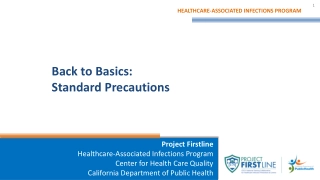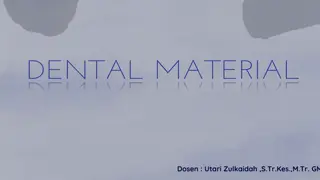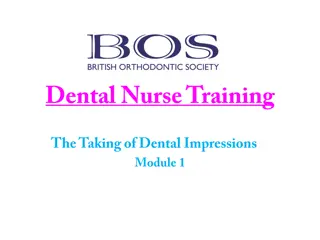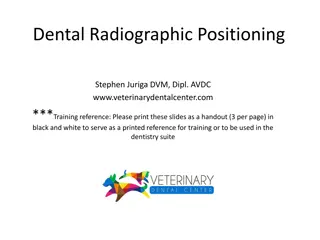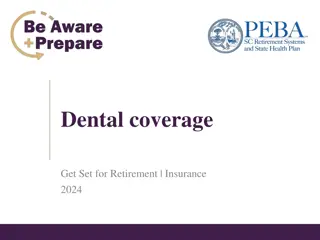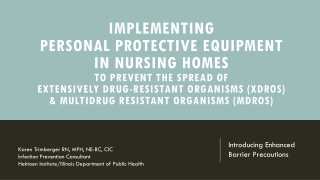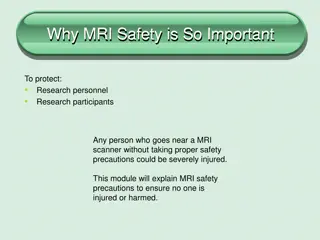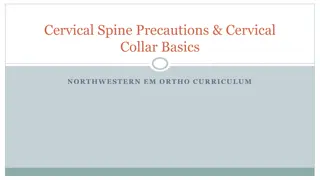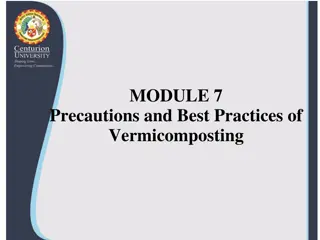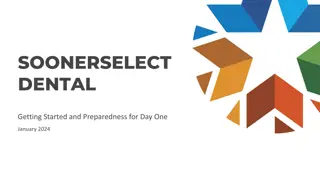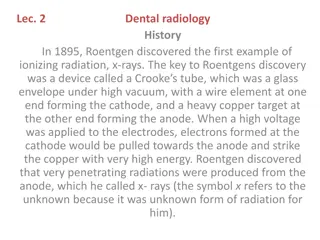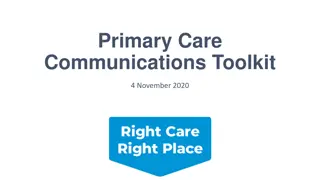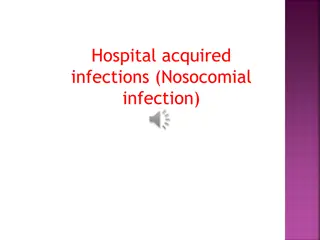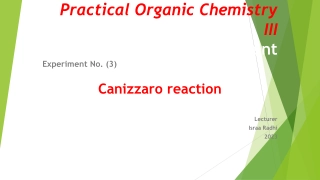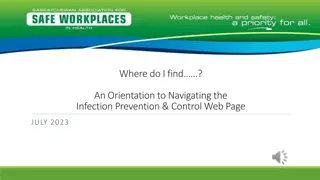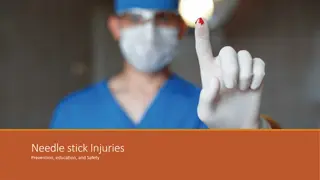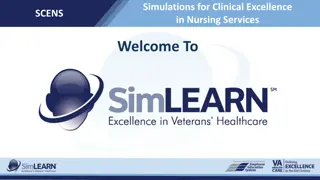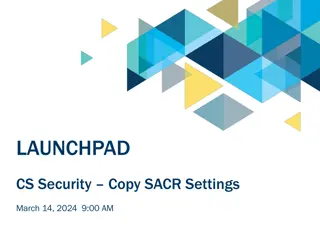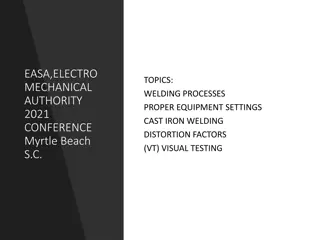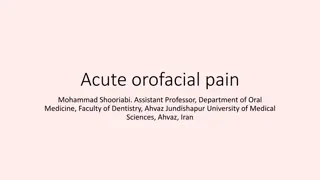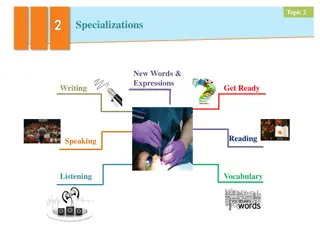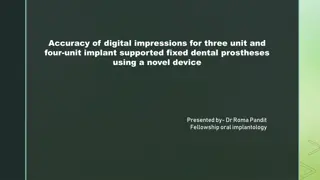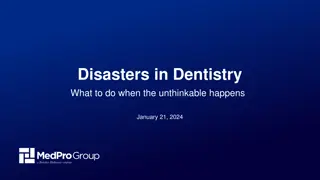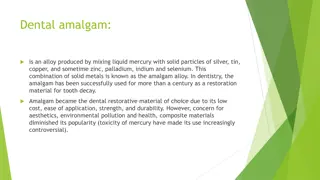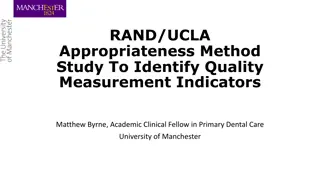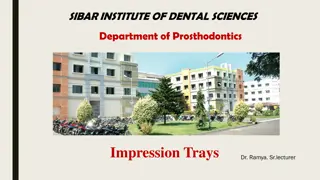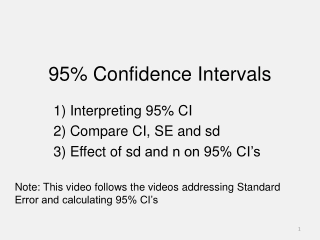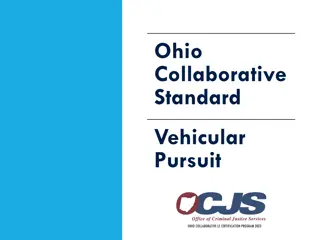Standard Precautions in Dental Settings
Standard Precautions in Dental Settings emphasize the importance of hand hygiene, proper use of personal protective equipment, aseptic techniques, clinical asepsis, and environmental surface disinfection to control infections. Adherence to these precautions minimizes the risk of spreading microorganisms in dental settings. The procedures include minimizing dental aerosols, using disposable items, applying pre-procedure mouth rinse, and aseptic distribution of dental supplies. Clinical asepsis procedures involve wearing PPE, disinfecting surfaces, and handling sterile instruments.
Download Presentation

Please find below an Image/Link to download the presentation.
The content on the website is provided AS IS for your information and personal use only. It may not be sold, licensed, or shared on other websites without obtaining consent from the author. Download presentation by click this link. If you encounter any issues during the download, it is possible that the publisher has removed the file from their server.
E N D
Presentation Transcript
Standard Precautions In Dental Settings GDIPC
Outline Hand Hygiene Personal Protective Equipment Aseptic Techniques Clinical Asepsis Environmental Surfaces Infection Control Infection Control in Dental lab and Prosthodontics Infection Control in Dental Radiography Sterilization of Patient Care Items Sterilization Monitoring References 2 STANDARD PRECAUTIONS IN DENTAL SETTINGS
Hand Hygiene 3 STANDARD PRECAUTIONS IN DENTAL SETTINGS
Personal Protective Equipment 4 STANDARD PRECAUTIONS IN DENTAL SETTINGS
Aseptic Techniques Brief Aseptic techniques are used to reduce or prevent microo rganisms from spreading from one place to another, such as from the patient to the DHCP or from an operating surface to the pat ient. The propose for such technique is to minimize risk of infection. All health workers are responsible of conforming to Aseptic techniques. 5 STANDARD PRECAUTIONS IN DENTAL SETTINGS
Aseptic Techniques Procedure There are several methods for aseptic techniques: 1) Touching as few surfaces as possible, including rubbing eyes, hair, skin, and noses. 2) Minimizing dental aerosols and spazzer. 3) Using high volume evacuation during the use of rotary equipment and air/water syringes. 4) Using disposable saliva ejector tips to prevent patients from touching the tip of the saliva ejector. 5) Using rubber dams to reduce microorganism escaping a patient s mouth. 6) Applying pre-procedure mouth rinse. 7) Using as much disposable items as possible. 8) Giving due care to housekeeping and cleaning. 9) Avoid using carpets and cloth furniture. 10) Aseptic distribution of dental supplies using two approaches; aseptic retrieval and unit dosing. 6 STANDARD PRECAUTIONS IN DENTAL SETTINGS
Clinical Asepsis Procedure Before seating the patient 1) Put on PPE and disinfect surfaces that may be touched during patient pro cedure such as countertops, drawer pulls, or sink faucet handles. 2) Clean and disinfect items brought to the clinic. 3) Disinfect pre-cleaned surfaces by respraying and allowing them to dry. 4) Remove and discard mask and gloves and perform hand hygiene. 5) Obtain surface covers, supplies, and sterile instruments from supply area. 6) Cover head rest, chair control buttons, handles, and switches. 7) Remove items not used during patient procedure. After seating Patient 1) Open instrument packages without touching instrument. 2) Perform hand hygiene. 3) Put on PPE. 4) Connect sterile hand pieces and sterile/disposable air water syringe tips. 7 STANDARD PRECAUTIONS IN DENTAL SETTINGS
Clinical Asepsis Procedure After Patient Treatment 1) Person cleaning the contaminated instrument must wear heavy utility PPE. 2) Remove gloves then mask. 3) Put on fresh gloves and mask. 4) Place all instruments on tray. 5) Place all disposable sharp items into sharp container. 6) Fluch the syringes, hand piece, and scaler into sink for 20-30 seconds. 7) Remove all surface covers. 8) Send instruments to sterilization area. 9) Remove disposable gown and gloves and dispose into waste container. 10) Perform hand hygiene. 8 STANDARD PRECAUTIONS IN DENTAL SETTINGS
Environmental Surfaces Infection Control Clinical Surface Clinical surfaces include dental chair, light handles, switches, dental radiograph equipment, dental chair-side computer, reusable container, drawer handles, and skin and faucet handles. The spread of micro-organisms can be minimized by two methods: a) using barriers, and b) cleaning and disinfecting. Barriers is the preferred method to prevent cross contamination. Materials incl ude include clear plastic wraps, bags, sheets and tubings. However, General cl eaning and disinfection should be performed. Cleaning and Disinfection is achieved by using detergent or surface agents t o remove organic matter, salts, and soil. The physical action of rubing kills the microorganism. Two methods of cleaning and disinfection: a) Spray-wipe-spray b) Wipe-discard-wipe 9 STANDARD PRECAUTIONS IN DENTAL SETTINGS
Environmental Surfaces Infection Control Housekeeping Surfaces Housekeeping surfaces are less likely to be contaminated. Examples include floors, walls, and sinks. These surfaces need to be cleaned only with water and detergent. PPE must be worn by housekeepers. Mops and cloths must be disinfected after every use, or better replaced with disposable ones. Floors and sinks should be cleaned daily, while walls and window coverings sh ould be cleaned every 3 months. Blood and boody fluid spillages must be managed using spill kits. To contain a spill: 1) Use absorbent pads to contain spill. 2) Put on PPE. 3) Use plastic scoop to remove broken glass. Sprinkle absorbent granules over spill and leave till it solidifies and then remove. 1) Waste absorbent material in yellow bags. 2) Wash hands. 10 STANDARD PRECAUTIONS IN DENTAL SETTINGS
Infection Control in Dental lab and Prosthodontics Proper methods for handling soiled items 1) Adherence to hand hygiene and PPE is a must . Design of the laboratory should be divided in to three areas: a) Receiving area b) Production area c) Shipping area Aseptic techniques should be applied whenev er patient materials or instruments are used. Unit-dose materials should be used whenever possible. Barrier techniques should be applied to instruments used in the dental lab such as face bows, articulators and torch handlers. Avoiding exposure incident by less usage of sharps and containing them. 2) 3) 4) 5) 6) 11 STANDARD PRECAUTIONS IN DENTAL SETTINGS
Infection Control in Dental lab and Prosthodontics Proper method for decontaminating soiled items Steam sterilization (Autoclave) is used for heat tolerant items in the mouth as well as contaminated laboratory items, Examples of such items are: 1) Metal impression trays 2) Burs 3) Rag wheels 4) Polishing points 5) Laboratory knives 6) Facebow forks 7) Handpieces and instruments 8) Polishing points 9) Water bath basins 10) Stainless steel bowels 11) Boley gauges 12) Metal rulers 13) Metal spatulas 14) Occlusal plane guides 15) Orthodontic pliers 16) Impression guns 12 STANDARD PRECAUTIONS IN DENTAL SETTINGS
Infection Control in Dental lab and Prosthodontics Proper method for decontaminating soiled items Disinfection is used for items that contact with mucous membrane, yet not us ed between patients. Otherwise, must be sterilized. Examples of such items: 1) Articulators 2) Face-bows 3) Lathes 4) Case pans 5) Pressure pots 6) Water baths 7) Shade guide Wooden-handled spatulas 8) Rubber mixing bowls 9) Torch Impressions also require disinfection. Disinfectant materials vary by material of impressions. There are several methods for disinfecting impressions: 1) Spraying Method. 2) Short-term Submersion. 3) Immersion Method. 13 STANDARD PRECAUTIONS IN DENTAL SETTINGS
Infection Control in Dental Radiography Intraoral radiography Intraoral radiography involves direct contact with saliva which may contaminat e the films, film holders, position-indicating devices, x-ray tube-head, door handles, as well as the timing controls and exposure switch. These contaminat ed items must not leave the x-ray room. Efforts at prevention of cross-contamination should be directed towards isolating or protecting: 1) Items which directly contact the oral cavity, such as a) Operator s hands b) Film packets c) Film holding devices and position indicating devices 2) Items contacted by the operator s hands (contact surfaces), such as: a) X-ray tube heads b) Control panel c) Chair operating controls d) Exposure buttons e) Door handles f) Lead apron 14 STANDARD PRECAUTIONS IN DENTAL SETTINGS
Infection Control in Dental Radiography Extraoral and digital radiography Barriers should cover non critical items used to stabilize and position the head such as ear rod, head positioners, and chin rests. Bite-blocks also should be covered by barriers. Disinfection is not sufficient. During extra-oral radiography, the operator s hands do not routinely contact the oral cavity. However, if the operator s gloves do become contaminated, then contact surfaces should not be touched and precautions must be taken as with intra-oral radiography. As for digital radiography, sensors must be covered with disposable barriers, a s well as the computer and work station components. 15 STANDARD PRECAUTIONS IN DENTAL SETTINGS
Sterilization of Patient Care Items General Recommendations 1) Repressing of dental instruments should be carried in central sterilization departm ents, not clinics Use only MOH-approved medical devices for sterilization. Clean and sterilize critical and semi-critica l dental instruments before each use. Allow packages to dry in sterilizer before being handled. Use heat-stable semi-critical alternatives whenever possible. Reprocess heat-sensitive instruments by u sing sterilant/high-level disinfectants or a low-temperature sterilization method. Use single-use disposable instruments wh enever possible. Do not use chemical or high level sterilan ts for environmental surface disinfection. 2) 3) 4) 5) 6) 7) 8) 16 STANDARD PRECAUTIONS IN DENTAL SETTINGS
Sterilization of Patient Care Items Processing area Divide the instrument processing area into distinct areas for: 1) Receiving, cleaning, and decontamination. 2) Preparation and packaging. 3) Sterilization. 4) Storage. 17 STANDARD PRECAUTIONS IN DENTAL SETTINGS
Sterilization Monitoring Types of monitoring 1) Mechanical monitoring involves examining and recording critical variables such as time, temperature, and pressure. It provides real time assessment of each cycle that is digitally displayed or printed out. 2) Chemical monitoring involves the use of external and internal indicators that change color or physical form when exposed to high temperatures or to certain combinations of time, temperature, and the presence of steam. There are three types of chemical indicators: a) External indicators are applied outside of each instrument package and rapidly change color to certain temperatures. b) Internal indicators are placed along with the items to be sterilized inside the packs and are slower yet more reliable changing. c) Bowie-Dick test is a special kind of indicator that tests air removal in vacuum and pre-vacuum steam sterilizers 3) Biological monitoring provides the main guarantee of sterilization. It evaluates the procedure's effectiveness. It is recommended on a weekly basis. 18 STANDARD PRECAUTIONS IN DENTAL SETTINGS
Sterilization Monitoring Positive spore test procedures The following are recommended in the case of a positive spore test: 1) Remove sterilizer and review the sterilization procedure to determine reason of error. 2) Retest sterilizer using either of indicator types. 3) Put sterilizer back to service in case of negative repeat spore test. The following are recommended if the repeat spore test is positive: 1) Do not use sterilizer till repaired or inspected for positive test reason. 2) Recall and reprocess all items since the last negative spore test. 3) Re-challenge sterilizer with biological indicator after reason of sterilization failure was determined and corrected. 19 STANDARD PRECAUTIONS IN DENTAL SETTINGS
References Centre for Disease Control (2018). Standard Precautions. https://www.cdc.gov/o ralhealth/infectioncontrol/summary-infection-prevention-practices/standa rd-precautions.html Saudi Ministry of Health (2018). Manual of Infection Prevention & Control in D ental Settings. Second edition. World Health Organization (2018). Standard precautions. https://www.who.int/c sr/resources/publications/EPR_AM2_E7.pdf 20 STANDARD PRECAUTIONS IN DENTAL HYGIENE


